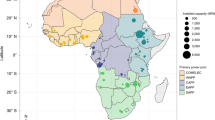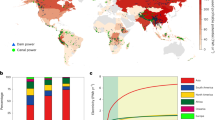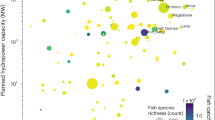Abstract
Around 100 GW of new hydropower projects have been proposed in continental Africa to contribute to meeting future energy demand. Yet, the future expansion of hydropower on the continent faces obstacles due to the impacts of dams on rivers, greenhouse gas emissions from reservoirs and increasingly competitive alternative renewable electricity technologies. Here we propose an integrated approach to include these considerations in energy planning. Compared with planning for least-cost energy systems, capacity expansion strategies balancing environmental and techno-economic objectives increase electricity prices and total discounted costs by at most 1.4% and 0.2%, respectively, while reducing impacts on annual hydropower emissions and river fragmentation by at least 50%. Our results demonstrate that refining techno-economic analysis in light of global and local environmental objectives can help policymakers reduce the river fragmentation and greenhouse gas emissions associated with hydropower development at marginal increases in energy costs.
This is a preview of subscription content, access via your institution
Access options
Access Nature and 54 other Nature Portfolio journals
Get Nature+, our best-value online-access subscription
$32.99 / 30 days
cancel any time
Subscribe to this journal
Receive 12 digital issues and online access to articles
$119.00 per year
only $9.92 per issue
Buy this article
- Purchase on SpringerLink
- Instant access to full article PDF
Prices may be subject to local taxes which are calculated during checkout





Similar content being viewed by others
Data availability
The OSeMOSYS-TEMBA energy system model data are available via Zenodo at https://doi.org/10.5281/zenodo.3521841 (ref. 81) in their modified version, including power plant data for more than 600 hydropower projects from the African Hydropower Atlas, which are available via Zenodo at https://doi.org/10.5281/zenodo.7931050 (ref. 82). The African Hydropower Atlas contains technical information about the existing and future hydropower projects and is available online (https://www.hydroshare.org/resource/5e8ebdc3bfd24207852539ecf219d915/). The GRAND database containing information about existing dams worldwide is available thanks to the Global Dam Watch project (https://www.globaldamwatch.org/grand). Emission factors are available from the National Renewable Energy Laboratory (https://data.nrel.gov/submissions/171). The SSPs report socio-economic projections using Integrated Assessment Models and are available online (https://tntcat.iiasa.ac.at/SspDb/dsd?Action=htmlpage&page=welcome). Figure 3, Supplementary Figs. 3 and 4, and Extended Data Fig. 1 incorporate data from the HydroSHEDS v.1 database, which is © World Wildlife Fund, Inc. (2006–2022) and has been used herein under licence. The World Wildlife Fund has not evaluated the data as altered and incorporated in these figures, and therefore gives no warranty regarding its accuracy, completeness, currency or suitability for any particular purpose. Portions of the HydroSHEDS v.1 database incorporate data that are the intellectual property rights of © USGS (2006–2008), NASA (2000–2005), ESRI (1992–1998), CIAT (2004–2006), UNEP-WCMC (1993), the World Wildlife Fund (2004), the Commonwealth of Australia (2007), and His Royal Majesty and the British Crown, and are used under licence. The HydroSHEDS v.1 database and more information are available at https://www.hydrosheds.org (ref. 70). All the data to reproduce the results and figures are available via Zenodo at https://doi.org/10.5281/zenodo.8360437 (ref. 83).
Code availability
All the processing scripts to reproduce the results and figures are available via Zenodo at https://doi.org/10.5281/zenodo.8360437 (ref. 83).
References
Kikstra, J. S., Mastrucci, A., Min, J., Riahi, K. & Rao, N. D. Decent living gaps and energy needs around the world. Environ. Res. Lett. 16, 095006 (2021).
Akintande, O. J., Olubusoye, O. E., Adenikinju, A. F. & Olanrewaju, B. T. Modeling the determinants of renewable energy consumption: evidence from the five most populous nations in Africa. Energy 206, 117992 (2020).
Africa Energy Outlook 2022: World Energy Outlook Special Report (IEA, 2022).
Renewable Power Generation Costs in 2022 (IRENA, 2023).
Zarfl, C., Lumsdon, A. E., Berlekamp, J., Tydecks, L. & Tockner, K. A global boom in hydropower dam construction. Aquat. Sci. 77, 161–170 (2015).
Gernaat, D. E., Bogaart, P. W., Vuuren, D. P. V., Biemans, H. & Niessink, R. High-resolution assessment of global technical and economic hydropower potential. Nat. Energy 2, 821–828 (2017).
Sterl, S. et al. A spatiotemporal atlas of hydropower in Africa for energy modelling purposes. Open Res. Eur. 1, 29 (2022).
Llamosas, C. & Sovacool, B. K. The future of hydropower? A systematic review of the drivers, benefits and governance dynamics of transboundary dams. Renew. Sustain. Energy Rev. 137, 110495 (2021).
Grill, G. et al. Mapping the world’s free-flowing rivers. Nature 569, 215–221 (2019).
Anderson, E. P. et al. Fragmentation of Andes-to-Amazon connectivity by hydropower dams. Sci. Adv. 4, eaao1642 (2018).
Zarfl, C. et al. Future large hydropower dams impact global freshwater megafauna. Sci. Rep. 9, 18531 (2019).
Barbarossa, V. et al. Impacts of current and future large dams on the geographic range connectivity of freshwater fish worldwide. Proc. Natl Acad. Sci. USA 117, 3648–3655 (2020).
Dias, M. S. et al. Anthropogenic stressors and riverine fish extinctions. Ecol. Indic. 79, 37–46 (2017).
Tickner, D. et al. Bending the curve of global freshwater biodiversity loss: an emergency recovery plan. BioScience 70, 330–342 (2020).
Schmitt, R. J., Bizzi, S., Castelletti, A. & Kondolf, G. Improved trade-offs of hydropower and sand connectivity by strategic dam planning in the Mekong. Nat. Sustain. 1, 96–104 (2018).
Schmitt, R. J. P., Bizzi, S., Castelletti, A., Opperman, J. & Kondolf, G. M. Planning dam portfolios for low sediment trapping shows limits for sustainable hydropower in the Mekong. Sci. Adv. 5 (2019).
Schmitt, R. J. et al. Strategic basin and delta planning increases the resilience of the Mekong Delta under future uncertainty. Proc. Natl Acad. Sci. USA 118, e2026127118 (2021).
Kondolf, G. et al. Save the Mekong Delta from drowning. Science 376, 583–585 (2022).
Winemiller, K. O. et al. Balancing hydropower and biodiversity in the Amazon, Congo, and Mekong. Science 351, 128–129 (2016).
Chowdhury, A. K. et al. Hydropower expansion in eco-sensitive river basins under global energy–economic change. Nat. Sustain. 7, 213–222 (2024).
Hertwich, E. G. Addressing biogenic greenhouse gas emissions from hydropower in LCA. Environ. Sci. Technol. 47, 9604–9611 (2013).
Deemer, B. R. et al. Greenhouse gas emissions from reservoir water surfaces: a new global synthesis. BioScience 66, 949–964 (2016).
Prairie, Y. T. et al. Greenhouse gas emissions from freshwater reservoirs: what does the atmosphere see? Ecosystems 21, 1058–1071 (2018).
Calamita, E. et al. Unaccounted CO2 leaks downstream of a large tropical hydroelectric reservoir. Proc. Natl Acad. Sci. USA 118, e2026004118 (2021).
Harrison, J. A., Prairie, Y. T., Mercier-Blais, S. & Soued, C. Year-2020 global distribution and pathways of reservoir methane and carbon dioxide emissions according to the greenhouse gas from reservoirs (G-res) model. Glob. Biogeochem. Cycles 35, e2020GB006888 (2021).
Soued, C., Harrison, J. A., Mercier-Blais, S. & Prairie, Y. T. Reservoir CO2 and CH4 emissions and their climate impact over the period 1900–2060. Nat. Geosci. 15, 700–705 (2022).
Ou, Y. et al. Role of non-CO2 greenhouse gas emissions in limiting global warming. One Earth 5, 1312–1315 (2022).
Haegel, N. M. et al. Terawatt-scale photovoltaics: transform global energy. Science 364, 836–838 (2019).
Veers, P. et al. Grand challenges in the science of wind energy. Science 366, eaau2027 (2019).
Meng, J., Way, R., Verdolini, E. & Diaz Anadon, L. Comparing expert elicitation and model-based probabilistic technology cost forecasts for the energy transition. Proc. Natl Acad. Sci. USA 118, e1917165118 (2021).
Chowdhury, A. K. et al. Enabling a low-carbon electricity system for Southern Africa. Joule 6, 1826–1844 (2022).
Carlino, A. et al. Declining cost of renewables and climate change curb the need for African hydropower expansion. Science 381, eadf5848 (2023).
Almeida, R. M. et al. Strategic planning of hydropower development: balancing benefits and socioenvironmental costs. Curr. Opin. Environ. Sustain. 56, 101175 (2022).
Almeida, R. M. et al. Reducing greenhouse gas emissions of Amazon hydropower with strategic dam planning. Nat. Commun. 10, 4281 (2019).
Schmitt, R. J., Kittner, N., Kondolf, G. M. & Kammen, D. M. Joint strategic energy and river basin planning to reduce dam impacts on rivers in Myanmar. Environ. Res. Lett. 16, 054054 (2021).
Flecker, A. S. et al. Reducing adverse impacts of Amazon hydropower expansion. Science 375, 753–760 (2022).
Opperman, J. J. et al. Balancing renewable energy and river resources by moving from individual assessments of hydropower projects to energy system planning. Front. Environ. Sci. 10, 2410 (2023).
Siala, K., Chowdhury, A. K., Dang, T. D. & Galelli, S. Solar energy and regional coordination as a feasible alternative to large hydropower in Southeast Asia. Nat. Commun. 12, 4159 (2021).
Gonzalez, J. M. et al. Designing diversified renewable energy systems to balance multisector performance. Nat. Sustain. 6, 415–427 (2023).
Neumann, F. & Brown, T. The near-optimal feasible space of a renewable power system model. Electr. Power Syst. Res. 190, 106690 (2021).
Howells, M. et al. OSeMOSYS: the Open Source Energy Modeling System: an introduction to its ethos, structure and development. Energy Policy 39, 5850–5870 (2011).
Taliotis, C. et al. An indicative analysis of investment opportunities in the African electricity supply sector—using TEMBA (The Electricity Model Base for Africa). Energy Sustain. Dev. 31, 50–66 (2016).
Pappis, I. et al. Energy Projections for African Countries (JRC, 2019).
Pappis, I. et al. The effects of climate change mitigation strategies on the energy system of Africa and its associated water footprint. Environ. Res. Lett. 17, 044048 (2022).
Chawanda, C. J., Nkwasa, A., Thiery, W. & van Griensven, A. Combined impacts of climate and land-use change on future water resources in Africa. Hydrol. Earth Syst. Sci. 28, 117–138 (2024).
Frieler, K. et al. Assessing the impacts of 1.5 C global warming—simulation protocol of the Inter-Sectoral Impact Model Intercomparison Project (ISIMIP2b). Geosci. Model Dev. 10, 4321–4345 (2017).
Riahi, K. et al. The Shared Socioeconomic Pathways and their energy, land use, and greenhouse gas emissions implications: an overview. Glob. Environ. Change 42, 153–168 (2017).
Grill, G., Dallaire, C. O., Chouinard, E. F., Sindorf, N. & Lehner, B. Development of new indicators to evaluate river fragmentation and flow regulation at large scales: a case study for the Mekong River Basin. Ecol. Indic. 45, 148–159 (2014).
Grill, G. et al. An index-based framework for assessing patterns and trends in river fragmentation and flow regulation by global dams at multiple scales. Environ. Res. Lett. 10, 015001 (2015).
Jager, H. I. et al. Getting lost tracking the carbon footprint of hydropower. Renew. Sustain. Energy Rev. 162, 112408 (2022).
Grochowicz, A., van Greevenbroek, K., Benth, F. E. & Zeyringer, M. Intersecting near-optimal spaces: European power systems with more resilience to weather variability. Energy Econ. 106496, 106496 (2023).
Rheinheimer, D. E., Tarroja, B., Rallings, A. M., Willis, A. D. & Viers, J. H. Hydropower representation in water and energy system models: a review of divergences and call for reconciliation. Environ. Res. Infrastruct. Sustain. 3, 012001 (2023).
Schmitt, R. J., Kittner, N., Kondolf, G. M. & Kammen, D. M. Deploy diverse renewables to save tropical rivers. Nature 569, 330–332 (2019).
Hatchard, S., Schmitt, R. J., Pianosi, F., Savage, J. & Bates, P. Strategic siting and design of dams minimizes impacts on seasonal floodplain inundation. Environ. Res. Lett. 18, 084011 (2023).
Allen, G. H. & Pavelsky, T. M. Global extent of rivers and streams. Science 361, 585–588 (2018).
Mayer, A., Castro-Diaz, L., Lopez, M. C., Leturcq, G. & Moran, E. F. Is hydropower worth it? Exploring Amazonian resettlement, human development and environmental costs with the Belo Monte project in Brazil. Energy Res. Soc. Sci. 78, 102129 (2021).
Trotter, P. A., Maconachie, R. & McManus, M. C. Solar energy’s potential to mitigate political risks: the case of an optimised Africa-wide network. Energy Policy 117, 108–126 (2018).
Sterl, S. et al. Smart renewable electricity portfolios in West Africa. Nat. Sustain. 3, 710–719 (2020).
Basheer, M. et al. Cooperative adaptive management of the Nile River with climate and socio-economic uncertainties. Nat. Clim. Change 13, 48–57 (2023).
Arnold, W., Salazar, J. Z., Carlino, A., Giuliani, M. & Castelletti, A. Operations eclipse sequencing in multipurpose dam planning. Earth’s Future 11, e2022EF003186 (2023).
Liu, Z. & He, X. Balancing-oriented hydropower operation makes the clean energy transition more affordable and simultaneously boosts water security. Nat. Water 1, 778–789 (2023).
Brown, C., Ghile, Y., Laverty, M. & Li, K. Decision scaling: linking bottom-up vulnerability analysis with climate projections in the water sector. Water Resour. Res. 48 (2012).
Schmitt, R. J., Rosa, L. & Daily, G. C. Global expansion of sustainable irrigation limited by water storage. Proc. Natl Acad. Sci. USA 119, e2214291119 (2022).
Conway, D., Dalin, C., Landman, W. A. & Osborn, T. J. Hydropower plans in Eastern and Southern Africa increase risk of concurrent climate-related electricity supply disruption. Nat. Energy 2, 946–953 (2017).
Wu, G. C. et al. Strategic siting and regional grid interconnections key to low-carbon futures in African countries. Proc. Natl Acad. Sci. USA 114, E3004–E3012 (2017).
Wu, G. C. et al. Avoiding ecosystem and social impacts of hydropower, wind, and solar in Southern Africa’s low-carbon electricity system. Nat. Commun. 15, 1083 (2024).
Sovacool, B. K., Gilbert, A. & Nugent, D. An international comparative assessment of construction cost overruns for electricity infrastructure. Energy Res. Soc. Sci. 3, 152–160 (2014).
Deshmukh, R., Mileva, A. & Wu, G. Renewable energy alternatives to mega hydropower: a case study of Inga 3 for Southern Africa. Environ. Res. Lett. 13, 064020 (2018).
Barnes, T., Shivakumar, A., Brinkerink, M. & Niet, T. OSeMOSYS Global, an open-source, open data global electricity system model generator. Sci. Data 9, 623 (2022).
Lehner, B. & Grill, G. Global river hydrography and network routing: baseline data and new approaches to study the world’s large river systems. Hydrol. Process. 27, 2171–2186 (2013).
Allen, P. M., Arnold, J. C. & Byars, B. W. Downstream channel geometry for use in planning-level models 1. J. Am. Water Resour. Assoc. 30, 663–671 (1994).
QGIS Geographic Information System (QGIS Association, 2024).
Hagberg, A., Swart, P. & Schult, D. Exploring Network Structure, Dynamics, and Function Using NetworkX (OSTI, 2008).
Life Cycle Assessment Harmonization (NREL, 2021); https://www.nrel.gov/analysis/life-cycle-assessment.html
O’Connor, P. et al. Hydropower Vision: A New Chapter for America’s 1st Renewable Electricity Source (US Department of Energy, 2016).
Pehl, M. et al. Understanding future emissions from low-carbon power systems by integration of life-cycle assessment and integrated energy modelling. Nat. Energy 2, 939–945 (2017).
Lehner, B. et al. High-resolution mapping of the world’s reservoirs and dams for sustainable river-flow management. Front. Ecol. Environ. 9, 494–502 (2011).
Bartos, M. pysheds: simple and fast watershed delineation in Python. GitHub https://github.com/mdbartos/pysheds (2020).
Prairie, Y. T. et al. A new modelling framework to assess biogenic GHG emissions from reservoirs: the G-res tool. Environ. Model. Softw. 143, 105117 (2021).
Hadka, D. & Reed, P. Borg: an auto-adaptive many-objective evolutionary computing framework. Evol. Comput. 21, 231–259 (2013).
Pappis, I., Sridharan, V., Usher, W. & Howells, M. JRC-TEMBA—African decarbonisation pathways. Zenodo https://doi.org/10.5281/zenodo.3521841 (2019).
Carlino, A. Data in support of ‘Declining cost of renewables and climate change curb the need for African hydropower expansion’. Zenodo https://doi.org/10.5281/zenodo.7931050 (2022).
Carlino, A., Schmitt, R., Clark, A. & Castelletti, A. Data and code in support of ‘Rethinking energy planning to mitigate environmental and climatic impacts of future African hydropower’. Zenodo https://doi.org/10.5281/zenodo.8360437 (2023).
Acknowledgements
A. Carlino acknowledges support from the European Union’s Horizon 2020 Research and Innovation programme GEOCEP under Marie Sklodowska-Curie grant agreement no. 870245. A. Carlino was partially funded by the European Union’s Horizon 2020 Research and Innovation Actions programme under the project SOS-WATER (grant agreement no. 101059264). A. Castelletti was partially funded by the European Union’s Horizon 2020 Research and Innovation programme under the GoNEXUS project (grant agreement no. 101003722).
Author information
Authors and Affiliations
Contributions
A. Carlino, R.S. and A. Castelletti conceptualized the project. A. Castelletti acquired the funding. A. Carlino and A. Clark curated the data. A. Carlino and A. Clark conducted the formal analyses. A. Carlino, R.S., A. Clark and A. Castelletti devised the methodology. A. Carlino, R.S. and A. Clark visualized the data. A. Carlino prepared the original paper draft. A. Carlino, R.S., A. Clark and A. Castelletti reviewed and edited the paper.
Corresponding author
Ethics declarations
Competing interests
The authors declare no competing interests.
Peer review
Peer review information
Nature Sustainability thanks Mohammed Basheer and the other, anonymous, reviewer(s) for their contribution to the peer review of this work.
Additional information
Publisher’s note Springer Nature remains neutral with regard to jurisdictional claims in published maps and institutional affiliations.
Extended data
Extended Data Fig. 1 Classification of proposed hydropower projects under the approaches considered.
We report the classification of individual hydropower projects (always selected, selected at least once, and never selected) under the energy system planning (a), strategic dam planning (b), and after the integration (c).
Supplementary information
Supplementary Information
Supplementary Notes 1 and 2, Figs. 1–25, Table 1 and refs. 1–22.
Rights and permissions
Springer Nature or its licensor (e.g. a society or other partner) holds exclusive rights to this article under a publishing agreement with the author(s) or other rightsholder(s); author self-archiving of the accepted manuscript version of this article is solely governed by the terms of such publishing agreement and applicable law.
About this article
Cite this article
Carlino, A., Schmitt, R., Clark, A. et al. Rethinking energy planning to mitigate the impacts of African hydropower. Nat Sustain 7, 879–890 (2024). https://doi.org/10.1038/s41893-024-01367-x
Received:
Accepted:
Published:
Issue date:
DOI: https://doi.org/10.1038/s41893-024-01367-x
This article is cited by
-
Strategizing renewable energy transitions to preserve sediment transport integrity
Nature Sustainability (2025)
-
Greening hydropower in Africa
Nature Sustainability (2024)
-
Turning straw into reduced graphene oxide
Nature Sustainability (2024)



